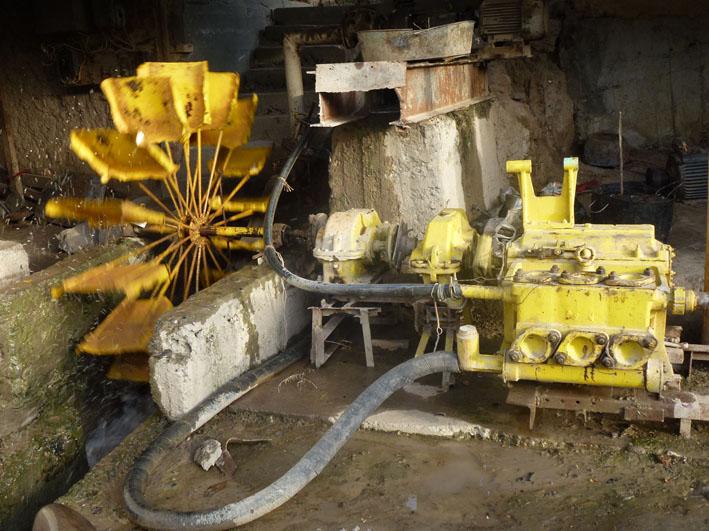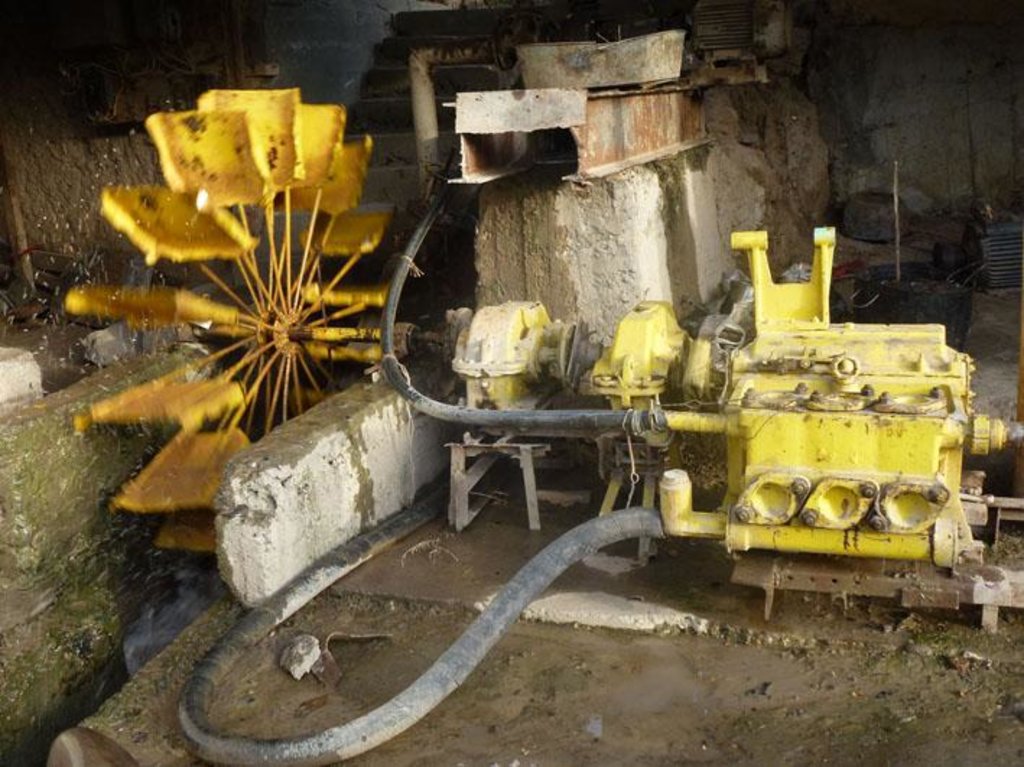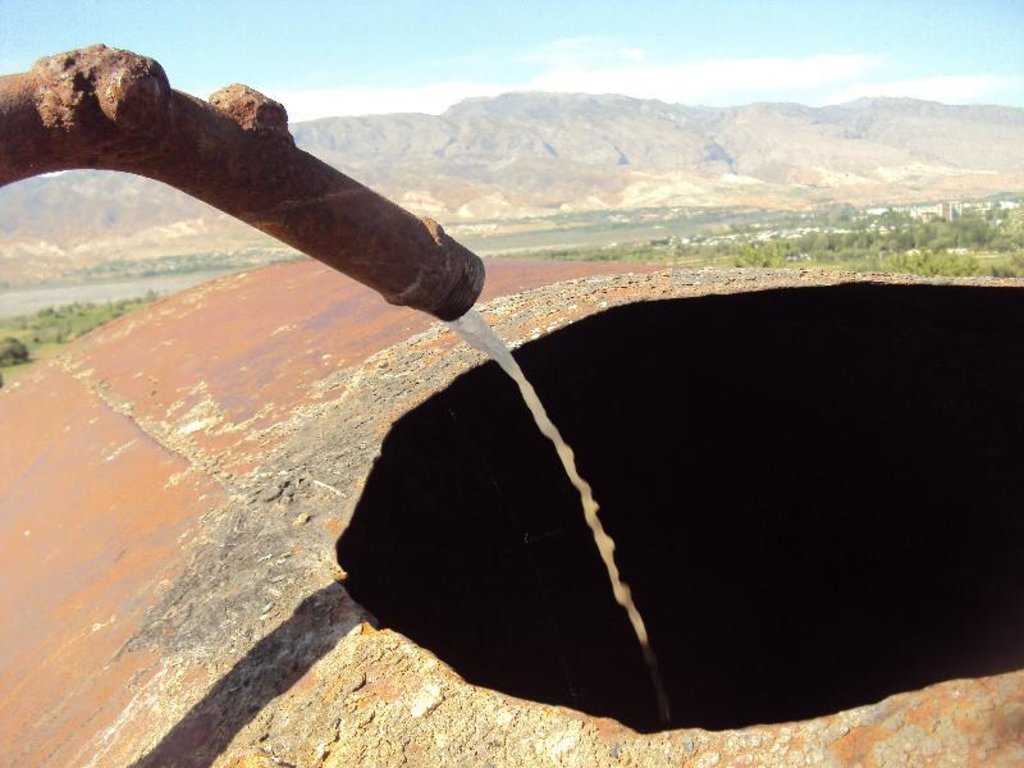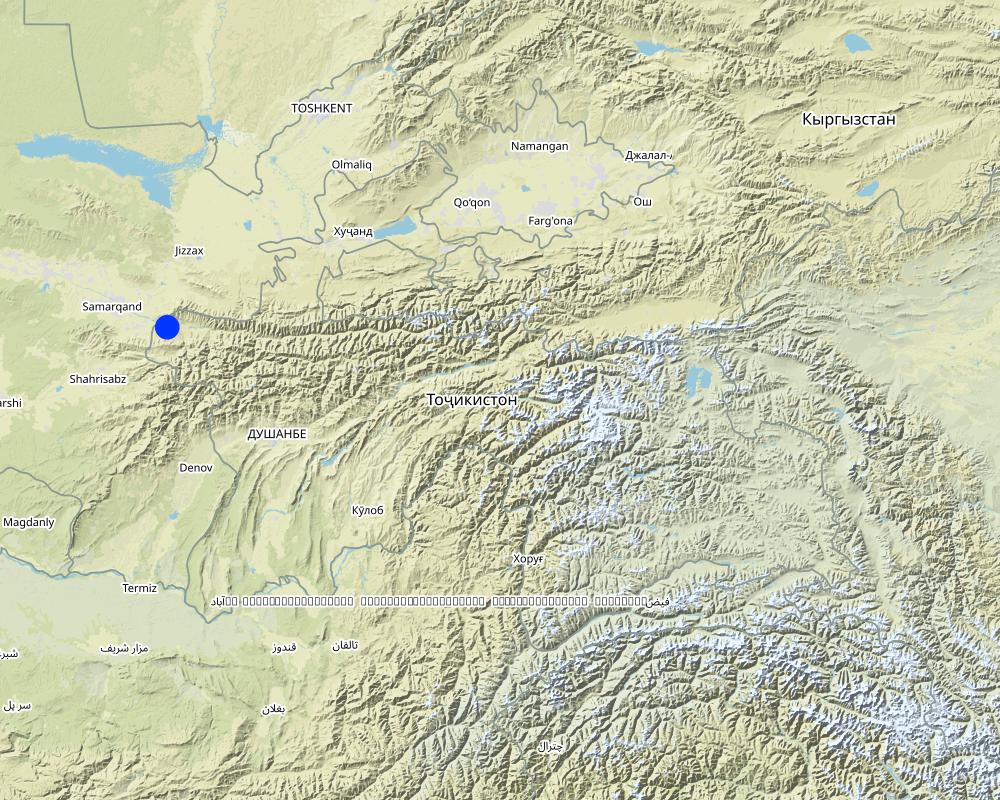Water wheel pump system [塔吉克斯坦]
- 创建:
- 更新:
- 编制者: Sa'dy Odinashoev
- 编辑者: –
- 审查者: Alexandra Gavilano, David Streiff, Joana Eichenberger
technologies_1051 - 塔吉克斯坦
查看章节
全部展开 全部收起1. 一般信息
1.2 参与该技术评估和文件编制的资源人员和机构的联系方式
有助于对技术进行记录/评估的项目名称(如相关)
Pilot Program for Climate Resilience, Tajikistan (WB / PPCR)有助于对技术进行记录/评估的机构名称(如相关)
CARITAS (Switzerland) - 瑞士有助于对技术进行记录/评估的机构名称(如相关)
NCCR North-South (NCCR North-South) - 吉尔吉斯斯坦1.3 关于使用通过WOCAT记录的数据的条件
编制者和关键资源人员接受有关使用通过WOCAT记录数据的条件。:
是
2. SLM技术的说明
2.1 技术简介
技术定义:
A water wheel that powers a pump that provides water to an orchard further upslope.
2.2 技术的详细说明
说明:
After the end of the Soviet era the mass irrigation system fell into disrepair, and many of the orchard areas subsequently suffered from dehydration and production levels declined. The case study plot is situated on a steep slope of 50° with stone/sand soils with high filtration rates.
As the irrigation systems no longer worked, the orchard in the Penjikent area lost much productivity and became very dry. As the quality of the soil is very poor the trees need much irrigation. The farmer often resorted to using a bucket to irrigate the orchards.
The land user developed a water powered pump using the flow from the existing river to pump water along a plastic pipe to the orchards. The pump can irrigate the orchard 200m above the river level. To help improve the process and regulate irrigation amount a large tank was installed in the orchard.
Purpose of the Technology: The purpose of the pump is to provide water 220m upslope to irrigate the orchards at minimal running costs, and not to be reliant on the often intermittent electricity supply.
Establishment / maintenance activities and inputs: The setting up the water wheel, pump, gear system, valves and piping system requires a certain level of technical knowledge. However, it is apparent that if you have a fast flowing river, water can be diverted to power a water wheel and a pump. Technical knowledge of the gearing will be required set up the ratios depending on the speed required for the water wheel.
Natural / human environment: In this area the very sandy soil, suffers from high infiltration rates and low water retention capacity. It is, therefore, unfavourable for growing any sort of water dependent crops. The water pump, albeit expensive in its initial financial expenditure does allow for irrigation of land, that would otherwise become increasingly denuded and degraded. The demise of the Soviet irrigation system means that the land users have had to invent and discover new innovative ways to irrigate the land.
2.3 技术照片
2.5 已应用该技术的、本评估所涵盖的国家/地区/地点
国家:
塔吉克斯坦
区域/州/省:
Sughd
有关地点的进一步说明:
Penjakent, Toshminor
具体说明该技术的分布:
- 均匀地分布在一个区域
如果不知道精确的区域,请注明大致覆盖的区域:
- < 0.1 平方千米(10 公顷)
注释:
This technology was developed by an individual in the region.
Map
×2.6 实施日期
如果不知道确切的年份,请说明大概的日期:
- 10-50年前
2.7 技术介绍
详细说明该技术是如何引入的:
- 通过土地使用者的创新
3. SLM技术的分类
3.1 该技术的主要目的
- improved access to irrigation
3.2 应用该技术的当前土地利用类型

牧场

森林/林地
- 植树造林
植树造林:说明树种的起源和组成:
- 单一栽培的本地品种
产品和服务:
- 薪材
- 水果和坚果
- 自然保持/保护
注释:
Livestock density (if relevant):
50-100 LU /km2
Major land use problems (compiler’s opinion): The land is very highly degraded, there is also limited vegetation due to the poor water supply
Major land use problems (land users’ perception): The land was very highly degraded and the soil condition was very poor.
Plantation forestry: mainly orchards
Forest products and services: fuelwood, fruits and nuts, nature conservation / protection
Future (final) land use (after implementation of SLM Technology): Cropland: Ct: Tree and shrub cropping
3.3 由于技术的实施,土地使用是否发生了变化?

牧场

森林/林地
3.4 供水
该技术所应用土地的供水:
- 充分灌溉
注释:
Number of growing seasons per year:
1
Specify:
Longest growing period in days: 220Longest growing period from month to month: March - October
3.5 该技术所属的SLM组
- 灌溉管理(包括供水、排水)
- 节能技术
3.6 包含该技术的可持续土地管理措施

农艺措施
- A2:有机质/土壤肥力

植物措施
- V1:乔木和灌木覆盖层

结构措施
- S11:其它

管理措施
- M1:改变土地使用类型
注释:
Main measures: structural measures
3.7 该技术强调的主要土地退化类型

土壤水蚀
- Wt:表土流失/地表侵蚀

化学性土壤退化
- Cn:肥力下降和有机质含量下降(非侵蚀所致)

生物性退化
- Bc:植被覆盖的减少
注释:
Main type of degradation addressed: Wt: loss of topsoil / surface erosion, Bc: reduction of vegetation cover
Secondary types of degradation addressed: Cn: fertility decline and reduced organic matter content
Main causes of degradation: Irrigation system (Water was not available for reafforestation.)
Secondary causes of degradation: change in temperature, change of seasonal rainfall, droughts (lack of rainfall is the main contributor to the degradation of the land.), war and conflicts
3.8 防止、减少或恢复土地退化
具体数量名该技术与土地退化有关的目标:
- 修复/恢复严重退化的土地
注释:
Secondary goals: prevention of land degradation, mitigation / reduction of land degradation
4. 技术规范、实施活动、投入和成本
4.1 该技术的技术图纸
技术规范(与技术图纸相关):
Technical knowledge required for land users: high (The design of the pump needs technical input.)
Main technical functions: water harvesting / increase water supply, water spreading
Secondary technical functions: improvement of ground cover, improvement of surface structure (crusting, sealing), increase in organic matter, increase of infiltration
Mulching
Material/ species: grass from the plot
Quantity/ density: 3 sm
Structural measure: water pump
4.2 有关投入和成本计算的一般信息
具体说明成本计算所用货币:
- 美元
注明雇用劳工的每日平均工资成本:
5.55
4.3 技术建立活动
| 活动 | 时间(季度) | |
|---|---|---|
| 1. | Construction of water pump | any |
4.4 技术建立所需要的费用和投入
| 对投入进行具体说明 | 单位 | 数量 | 单位成本 | 每项投入的总成本 | 土地使用者承担的成本% | |
|---|---|---|---|---|---|---|
| 劳动力 | Construction of water pump | Persons/day | 20.0 | 5.55 | 111.0 | 100.0 |
| 施工材料 | Machine parts | for 1 pump | 1.0 | 50.0 | 50.0 | 100.0 |
| 施工材料 | Welding rod | for 1 pump | 1.0 | 5.0 | 5.0 | 100.0 |
| 施工材料 | Drilling pump | for 1 pump | 1.0 | 1200.0 | 1200.0 | 100.0 |
| 施工材料 | Gear system | for 1 pump | 1.0 | 200.0 | 200.0 | 100.0 |
| 施工材料 | Valve gates | for 1 pump | 1.0 | 25.0 | 25.0 | 100.0 |
| 施工材料 | Stone | for 1 pump | 1.0 | 220.0 | 220.0 | 100.0 |
| 施工材料 | Pipes | for 1 pump | 1.0 | 1035.0 | 1035.0 | 100.0 |
| 施工材料 | Tank | for 1 pump | 1.0 | 500.0 | 500.0 | 100.0 |
| 技术建立所需总成本 | 3346.0 | |||||
| 技术建立总成本,美元 | 3346.0 | |||||
4.6 维护/经常性活动所需要的费用和投入(每年)
注释:
Costs are based upon 2010 prices.
4.7 影响成本的最重要因素
描述影响成本的最决定性因素:
The initial set up costs are quite high, but the actual operating costs are minimal.
5. 自然和人文环境
5.1 气候
年降雨量
- < 250毫米
- 251-500毫米
- 501-750毫米
- 751-1,000毫米
- 1,001-1,500毫米
- 1,501-2,000毫米
- 2,001-3,000毫米
- 3,001-4,000毫米
- > 4,000毫米
农业气候带
- 半干旱
Thermal climate class: temperate
5.2 地形
平均坡度:
- 水平(0-2%)
- 缓降(3-5%)
- 平缓(6-10%)
- 滚坡(11-15%)
- 崎岖(16-30%)
- 陡峭(31-60%)
- 非常陡峭(>60%)
地形:
- 高原/平原
- 山脊
- 山坡
- 山地斜坡
- 麓坡
- 谷底
垂直分布带:
- 0-100 m a.s.l.
- 101-500 m a.s.l.
- 501-1,000 m a.s.l.
- 1,001-1,500 m a.s.l.
- 1,501-2,000 m a.s.l.
- 2,001-2,500 m a.s.l.
- 2,501-3,000 m a.s.l.
- 3,001-4,000 m a.s.l.
- > 4,000 m a.s.l.
关于地形的注释和进一步规范:
Landforms: Also valles floors
5.3 土壤
平均土层深度:
- 非常浅(0-20厘米)
- 浅(21-50厘米)
- 中等深度(51-80厘米)
- 深(81-120厘米)
- 非常深(> 120厘米)
土壤质地(表土):
- 粗粒/轻(砂质)
表土有机质:
- 低(<1%)
如有可能,附上完整的土壤描述或具体说明可用的信息,例如土壤类型、土壤酸碱度、阳离子交换能力、氮、盐度等。:
Topsoil organic matter: Soil is very degraded
Soil fertility is very low
Soil drainage / infiltration is good
Soil water storage capacity is very low
5.4 水资源可用性和质量
地下水位表:
> 50米
地表水的可用性:
匮乏/没有
水质(未处理):
良好饮用水
关于水质和水量的注释和进一步规范:
Ground water table: The higher up the slope the deeper the water table.
5.5 生物多样性
物种多样性:
- 低
5.6 应用该技术的土地使用者的特征
生产系统的市场定位:
- 生计(自给)
非农收入:
- 低于全部收入的10%
相对财富水平:
- 贫瘠
- 平均水平
个人或集体:
- 个人/家庭
机械化水平:
- 手工作业
性别:
- 男人
说明土地使用者的其他有关特征:
Land users applying the Technology are mainly Leaders / privileged
Population density: 10-50 persons/km2
Annual population growth: 1% - 2%
10% of the land users are rich.
40% of the land users are average wealthy.
30% of the land users are poor.
20% of the land users are poor.
Off-farm income specification: Many people are interested in adopting of the technology.
5.7 应用该技术的土地使用者使用的平均土地面积
- < 0.5 公顷
- 0.5-1 公顷
- 1-2 公顷
- 2-5公顷
- 5-15公顷
- 15-50公顷
- 50-100公顷
- 100-500公顷
- 500-1,000公顷
- 1,000-10,000公顷
- > 10,000公顷
这被认为是小规模、中规模还是大规模的(参照当地实际情况)?:
- 中等规模的
5.8 土地所有权、土地使用权和水使用权
土地所有权:
- 州
土地使用权:
- 租赁
- Throgh association
用水权:
- 自由进入(无组织)
- Throgh association
5.9 进入服务和基础设施的通道
健康:
- 贫瘠
- 适度的
- 好
教育:
- 贫瘠
- 适度的
- 好
技术援助:
- 贫瘠
- 适度的
- 好
就业(例如非农):
- 贫瘠
- 适度的
- 好
市场:
- 贫瘠
- 适度的
- 好
能源:
- 贫瘠
- 适度的
- 好
道路和交通:
- 贫瘠
- 适度的
- 好
饮用水和卫生设施:
- 贫瘠
- 适度的
- 好
金融服务:
- 贫瘠
- 适度的
- 好
6. 影响和结论性说明
6.1 该技术的现场影响
社会经济效应
生产
作物生产
木材生产
生产故障风险
生产区域
土地管理
水资源可用性和质量
家畜用水的可用性
灌溉用水的可用性
收入和成本
农业投入费用
工作量
社会文化影响
SLM/土地退化知识
Livelihood and human well-being
注释/具体说明:
Timber and fruit production has increased on the irrigated land.
生态影响
水循环/径流
水量
水质
水的回收/收集
土壤
土壤水分
土壤覆盖层
土壤结壳/密封
6.2 该技术的场外影响已经显现
水资源可用性
缓冲/过滤能力
6.3 技术对渐变气候以及与气候相关的极端情况/灾害的暴露和敏感性(土地使用者认为的极端情况/灾害)
渐变气候
渐变气候
| 季节 | 增加或减少 | 该技术是如何应对的? | |
|---|---|---|---|
| 年温度 | 增加 | 好 |
气候有关的极端情况(灾害)
气象灾害
| 该技术是如何应对的? | |
|---|---|
| 局地暴雨 | 好 |
| 局地风暴 | 好 |
气候灾害
| 该技术是如何应对的? | |
|---|---|
| 干旱 | 好 |
水文灾害
| 该技术是如何应对的? | |
|---|---|
| 比较和缓的(河道)洪水 | 好 |
注释:
In the winter months, the pipe may become frozen and split. The pipe could be insulated to help prevent this happening.
6.4 成本效益分析
技术收益与技术建立成本相比如何(从土地使用者的角度看)?
短期回报:
稍微积极
长期回报:
非常积极
技术收益与技术维护成本/经常性成本相比如何(从土地使用者的角度看)?
短期回报:
稍微积极
长期回报:
非常积极
6.5 技术采用
- 单例/实验
如若可行,进行量化(住户数量和/或覆盖面积):
1 household
在所有采用这项技术的人当中,有多少人是自发的,即未获得任何物质奖励/付款?:
- 91-100%
注释:
100% of land user families have adopted the Technology without any external material support
There is a little trend towards spontaneous adoption of the Technology
Comments on adoption trend: Many farmers and projects are interested in implementing the technolgy in the future.
6.7 该技术的优点/长处/机会
| 土地使用者眼中的长处/优势/机会 |
|---|
| Has improved their livelihood considerably, feel more secure. |
| 编制者或其他关键资源人员认为的长处/优势/机会 |
|---|
|
An increase in the production of wood, fruit and timber. How can they be sustained / enhanced? More training on tree cultivation techniques. |
| Decrease in the workload, previously the trees were irrigated using a bucket |
| The quality of the soil has increased with a reduction in crusting of the surface due to drying out. |
6.8 技术的弱点/缺点/风险及其克服方法
| 土地使用者认为的弱点/缺点/风险 | 如何克服它们? |
|---|---|
| Took some time to pay for all materials |
| 编制者或其他关键资源人员认为的弱点/缺点/风险 | 如何克服它们? |
|---|---|
| High initial cost. | Loans could be made available. |
| High level of technical knowledge required to construct and maintain. | Training could be provided to interested personnel. |
7. 参考和链接
7.1 信息的方法/来源
链接和模块
全部展开 全部收起链接
无链接
模块
无模块





